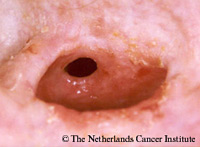Choosing the right prosthesis length

Care should be taken to replace the prosthesis with one of the correct length, in order to ensure proper function and to avoid undesirable side effects. A slightly too long prosthesis is not problematic, whereas a very tight fitting device might cause edema, which makes the prosthesis rapidly being ‘too short’. During follow-up, the thickness of the trachea wall might change, due to subsiding of surgical or radiation edema, or due to infection, making the fistula tract shorter (right figure and videoclip) or longer, respectively
Therefore, never replace the prosthesis automatically with one of the same size. Always check first if the length is still correct by grasping the flange of the prosthesis with a hemostat and slightly pulling it outward (right figure). Judge the distance between the flange and the tracheal mucosa, and if this is less than 2-3 mm, the same length can be chosen. In case of a greater distance, the prosthesis length should be chosen accordingly, but it has to be kept in mind that only rarely more than one size down should be used.
In case the tracheal flange shows some deformation, this might indicate that the prosthesis is too short and a longer version should be used. Use of a prosthesis with a longer shaft should also be considered if the tracheal mucosa shows a tendency to become hypertrophic and to bulge over the tracheal flange.
In case the tracheal flange shows some deformation, this might indicate that the prosthesis is too short and a longer version should be used. Use of a prosthesis with a longer shaft should also be considered if the tracheal mucosa shows a tendency to become hypertrophic and to bulge over the tracheal flange.
In case of doubt, the Provox measure can be used to establish the actual length of the TE-fistula (in case of a 20-23 Fr. diameter prosthesis; see also videoclip).